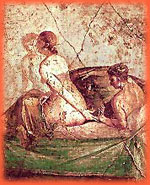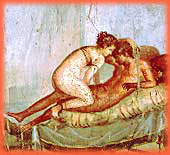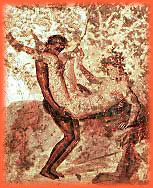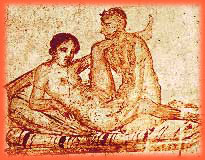|
 At
the beginning of the excavations started in Pompei
and Ercolano frescoes, statues and mosaics characterized
by an evident erotic content were found. At
the beginning of the excavations started in Pompei
and Ercolano frescoes, statues and mosaics characterized
by an evident erotic content were found.
This discovery upset all the ideas concerning
the ethic values of the ancient people that got
famous during the previous centuries. They discoverd
the ancient Greek-Roman world from a new and surprising
point of view.
Sexuality was exhibited without shame and it seemed
to be a very important element of everyday life.
Bourbons decided at first to censure the erotic
founds especially for the fact that Grand Tour
foreign travellers started talking about the dissolute
past and present costums of the Reign of Naples.
In 1851 the entrance door was walled up. As you
can imagine, the censorship let grow the general
curiosity. A collection of 'priaps' was instituited
in a room of the Royal Museum in Portici; in order
to visit it they needed a special permission.
In 1821 a 'Study of obscene objects' was opend;
by the passing of time it also collected more
recent works as the Danae by Titian. With unity
of Italy it was decided to open the erotic collection
to the pubblic as a sign of changed and modernity
in opposition to the repressive politics of the
Bourbon dominion.
To Giuseppe Fiorelli was assigned the task to
order the collection and draw up its catalogue;
in order to impart lustre and national importance
to a such original art collection it was enlarged
acquiring new founds.
During the Twentyth century only few people could
visit the erotic study. It was opened again in
1976 but soon it was closed in order to restore
it; it was then finally opened in the spring of
the year 2000.
Visiting the neapolitan collection you will see
also pre-roman i.e. Greek, Etrurian works whose
erotic iconography seem to be ispired by the Greek
culture as well.
 There
are also some votive offerings coming from the
popular religion of centre Italy; they represent
some parts of the human body and were offered
as good wish or thanks for recoveries in the sanctuaries. There
are also some votive offerings coming from the
popular religion of centre Italy; they represent
some parts of the human body and were offered
as good wish or thanks for recoveries in the sanctuaries.
The biggest part of the collection is made of
mythologic paintings that were beloved mostly
by rich people as consequence to the Greek influence.
These paintings are about the illicit love affairs
of Mars and Venus, Polifemo and Galatea; the dressing
ups of Jupeter as in the painting 'Leda and swam'
represent the love metamorphosis really famous
at that time.
Also ermafrodite (the Frigian god with the woman
body and the penis) and satir were painted very
much.
The roman house garden was usually the most decored
place with erotic themes.
The garden was Priap reign; Priap was the Frigian
god with an enormous penis that he used in order
to punish the fruit thieves, raping them.
The garden as natural place was also the world
of mysterious beings as Pan, Dionisius, satirs
and pigmies. The pigmies lived in Africa and they
represent the opposite ideal kind of human being;
they assigned them an excessive sexual activity
at the open air. Pigmies were often painted on
the triclinus desks that were put in Pompeii at
the open air. Already in the Greek world the 'banchetto'
was the place of luxury.
Besides the triclinus also the objects using during
the meals (glasses, silver cups, trays, vases,
small statues) were decorated with erotic themes.
Also the paintings that decorated places of pleasure
were ispired by the Greek culture, many frescoes
with love positions were found in Pompeii private
rich houses or in the 'meretriciae' cells (i.e.
the places where the prostitution was practised).
 The
'meretriciae' cells were linked to taverns or
pubblic toilets. In Pompeii there were also found
talismans (used to protect against bad luck and
diseases): fired clay skylights, bronze bells
and statues with erected penis. The
'meretriciae' cells were linked to taverns or
pubblic toilets. In Pompeii there were also found
talismans (used to protect against bad luck and
diseases): fired clay skylights, bronze bells
and statues with erected penis.
The representation of penis was often painted
in Pompeii baker's and shops façades as
symbol of protection. To the collection of the
Museum belong also some Egyptian works that were
bought in 1815 by Stefano Borgia according to
Ferdinando IV will.
Some ojects, as for istance stone dwarves with
big penis in their hands seem to be original,
some others are more closed to the Settecento
taste and therefore they seem to be false, but
interesting anyway for understanding the age of
the collector.
|




 At
the beginning of the excavations started in Pompei
and Ercolano frescoes, statues and mosaics characterized
by an evident erotic content were found.
At
the beginning of the excavations started in Pompei
and Ercolano frescoes, statues and mosaics characterized
by an evident erotic content were found.
 There
are also some votive offerings coming from the
popular religion of centre Italy; they represent
some parts of the human body and were offered
as good wish or thanks for recoveries in the sanctuaries.
There
are also some votive offerings coming from the
popular religion of centre Italy; they represent
some parts of the human body and were offered
as good wish or thanks for recoveries in the sanctuaries. The
'meretriciae' cells were linked to taverns or
pubblic toilets. In Pompeii there were also found
talismans (used to protect against bad luck and
diseases): fired clay skylights, bronze bells
and statues with erected penis.
The
'meretriciae' cells were linked to taverns or
pubblic toilets. In Pompeii there were also found
talismans (used to protect against bad luck and
diseases): fired clay skylights, bronze bells
and statues with erected penis.